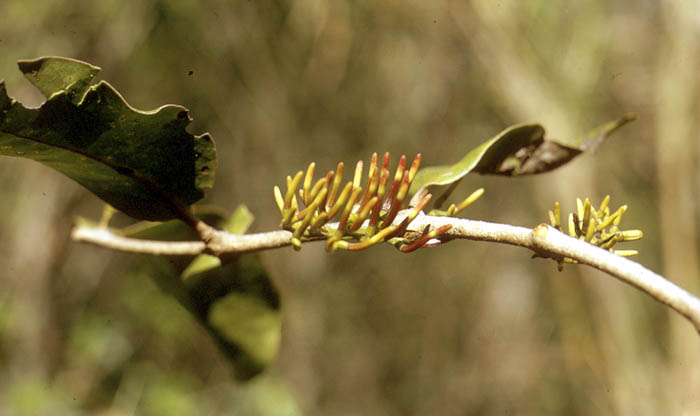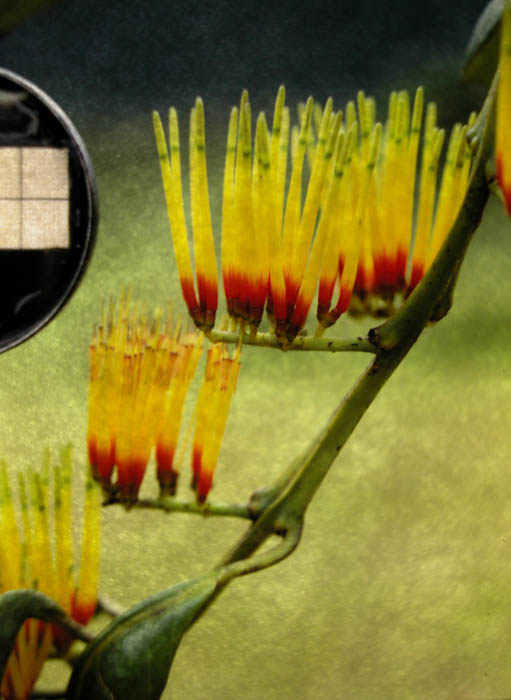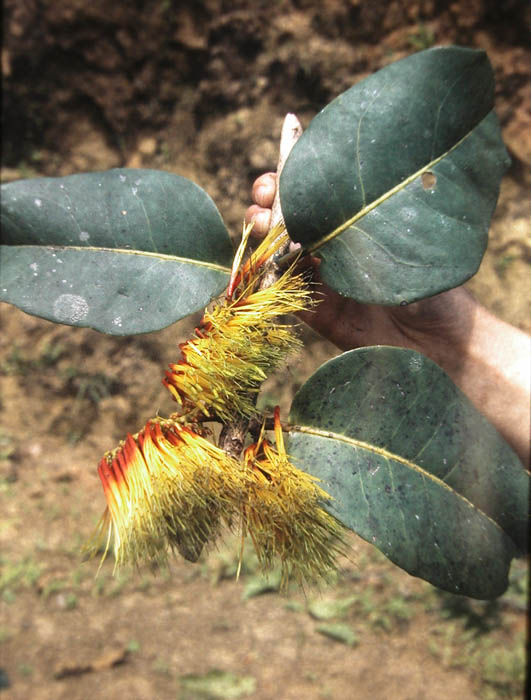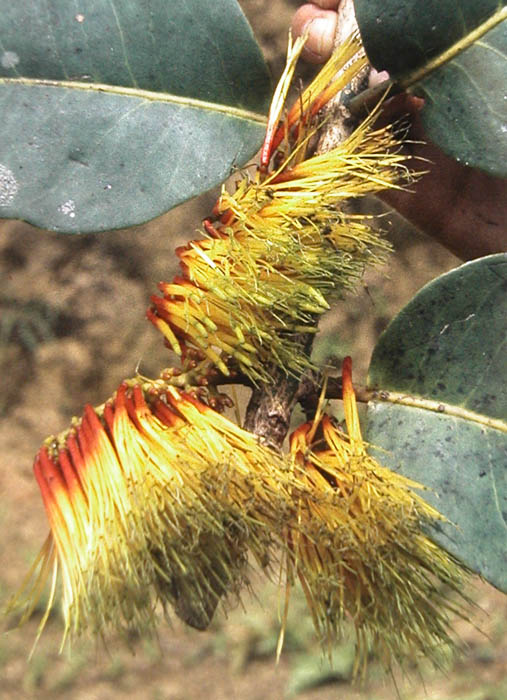
12 species recorded from New Guinea. Click on a name to go to its species page. Species with photographs shown with red asterisk (*).
Description and key to all species of Decaisnina, from Barlow (1993)
Description of New Guinea species of Decaisnina, from Barlow (1974)
Decaisnina Tiegh. Bull. Soc. Bot. Fr. 42: 434, 435 (1895); Barlow, Aust. J. Bot. 14:432 (1966); Amylotheca sect. Decaisnina (Tiegh.) Engl. & Krause, Pfl. Fam. ed. 2 16b: 139 (1935). Type Species.-D. glauca Tiegh. (= D. triflora (Span.) Tiegh.).
Treubella Tiegh. Bull. Soc. bot. Fr. 41: 258, 265 (1894) nom. illeg.. non Pierre (1890); Treubania Tiegh. J. de Bot. 11: 324 (1897); Elytranthe subgen. Paleoelytranthe sect. Neotreubella Engl.Pfl. Fam. Nachtr. 126 (1897); Loranthus sect. Neotreubella (Engl.) Blakely, Proc. Linn. Soc. N.S.W. 47: 393 (1922); Amylotheca sect. Neotreubella (Engl.) Engl.& Krause, Pfl. Fam. ed. 2 16b: 139 (1935). Type Species. T. forsteriana (Schult.) Tiegh.
Aerial stem-parasitic shrubs with runners and opposite penninerved leaves. Inflorescence axillary, a raceme of several decussate pairs of dichasia (triads) with all flowers sessile or the lateral flowers shortly pedicellate; bracts single under each flower. Corolla in the mature bud uniformly slender; petals in the open flower 6, free or shortly united at the base. Anthers narrow, acute, basifixed; pollen trilobate. Style articulate at or above the base. Basic Chromosome Number.- x = 12.
A genus of about 30 species, extending from the Philippines to northern Australia and Tahiti. Of the nine species occurring in New Guinea and the southwestern Pacific region, six are endemic, one extends to Cape York Peninsula, Queensland, one extends to the adjacent Indonesian islands, and one extends to both of these areas.
The genera Treubella and Decaisnina were distinguished by van Tieghem on the basis of whether or not the anthers were transversely septate. The usual condition in the Loranthaceae is that the anthers are not transversely septate, and transversely septate anthers occur only sporadically throughout the family. The character occasionally occurs as a variation within a species, and has been given little taxonomic value. For a further note on the circumscription of the genus Decaisnina, see Barlow (1966).
1a. Corolla less than 10 mm long 4. D. micranthes
1b. Corolla more than 10 mm long 2
2a. Petals eventually free to the base (sometimes long coherent
for 1-3 mm) 3
2b. Petals united in the lower 1-8 mm 4
3a. Corolla mostly 35-45 mm long, red. Lamina 5-7 cm long,
more or less shining above 2. D. forsteriana
3b. Corolla mostly 20-26 mm long, pale coloured. Lamina 8-14 cm
long, dull on both sides 1. D. djamuensis
4a. Lamina rounded at the base, sessile 5. D. papuana (NOTE: now in Cyne)
4b. Lamina attenuate or contracted at the base, more or less distinctly
petiolate 5
5a. Lamina shining above, dull below 6
5b. Lamina dull, with the same texture on both sides 7
6a. Lamina 5-7-(10) cm long, attenuate at the base. Corolla mostly
less than 30 mm long 6. D. parvifolia (NOTE:
now in D. sumbawensis)
6b. Lamina (5)-8-18-(25) cm long, contracted to slightly
cordate at the base. Corolla more than 30 mm long 3. D.
hollrungii
7a. Lateral flowers of the triads on pedicels c. 1
mm long. Inflorescence axis c. 1 cm long 7. D. pedicellata
7b. Lateral flowers of the triads sessile or nearly so.
Inflorescence axis more than 3 cm long 8
8a. Fruit tomentose. Young stems green, flattened and usually
double edged. 8. D. stenopetala
8b. Fruit glabrous. Young stems darkcoloured, very
slightly flattened and soon becoming terete.9. D. triflora

Photo by Del Wiens

From Star Mts. Expedition (1975). Busilmin, 5000 ft elev. LAE 66781. Photo by W. R. Barker.


Decaisnina Genus
Page
last updated 28 June 2003